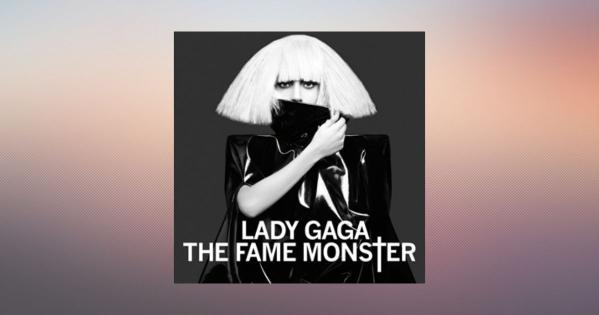Caught in a Bad Romance with Lady Gaga

Welcome to Feature Fridays! Each week, Music Library staff highlight an item from our collection. This week, student assistant Emily Brignand reviews The Fame Monster by Lady Gaga.
I remember vividly when the song “Poker Face” hit the charts and revealed the superstar who was previously writing songs for Brittney Spears, Jennifer Lopez, and many other singers behind the scenes. Many skeptics and music critics were doubtful of Lady Gaga’s potential and were highly cynical when judging and reviewing her figure, early music, and career. However, she has proven her worth as a musician, songwriter, actress, and fashion icon over the years by continuously revamping her music, reinventing her image, and building a unique bond with the general audience and with her Little Monsters (her fandom) to overcome the challenges and barriers set in front of her by haters of her self-expression. As I admire my first tattoo inspired by Lady Gaga and my love for music, here is a brief introduction of the artist and review of one of her most celebrated and renowned albums – The Fame Monster.
Stefani Joanne Angelina Germanotta, more widely known as Lady Gaga, was born in New York City on March 28, 1986. After dropping out of New York University’s Tisch School of the Arts to pursue a career in music, she worked as a songwriter for Sony Music Publishing where she signed a record deal with Interscope Records in 2007. Soon after, Gaga was launched into pop-world fame with the releases of “Just Dance” and “Poker Face” and her eventual reissue pop album The Fame Monster in 2009; her early musical and artistic versatility was unmatched and promoted her success as an artist today.
Winding back to the release of The Fame Monster on November 18, 2009, with the rise of electro-pop music, Gaga’s second album was very well received by the public and a safe step forward for Gaga as she was still establishing her place as a newly risen popstar. The album is a two-part piece that combines her debut album The Fame and her supposed stand-alone EP The Fame Monster. Before the addition of the “Monster,” the first part of the album, The Fame was motivated by her bold mission to “inject gay culture into the mainstream.” The second part opens with her first single “Just Dance.” This disco synth-pop was a catchy dance hit that climbed all the way to the Billboard Hot 100. Both “Love Game” and “Paparazzi,” two of the five singles in the album, maintain the theme of “Fame” that truly pushed Gaga to the top of the chart and expresses Gaga’s dark side and her sexuality. “Poker Face” was the gateway for most people who discovered her since it was a huge radio hit that had a catchy, repetitive melody and phrase that 6-year-old me could sing along to. Five bomb singles opening the The Fame basically guaranteed its place among music critics and average listeners. Even though the genre of the album is mostly synth-pop mixed with dance and disco music, there are also ballads like “Eh, Eh (Nothing Else I Can Say)” and “Brown Eyes” and heavy auto-tuned EDM’s like “I Like It Rough” and “Paper Gangsta.”
When deciding to make The Fame Monster a two-part album instead of an EP with the intention to convey the darker side of her and society, and that “fame is a monster in society,” Gaga intentionally creates the mood of the two parts as opposites, Yin and Yang. The eight additional songs from the first part of her album, The Fame Monster, are not only sonically refreshing from the second part but also filled in the missing puzzle The Fame needed to feel like a complete piece. The album begins with “Bad Romance,” like “Poker Face,” it is a widely known and loved track that never gets old. Unlike The Fame, which is mostly synth-pop that also explores and experiments with different shades of pop, The Fame Monster is cohesively dark and EDM besides the ballad, “Speechless.” Songs like “Alejandro,” “Monster,” and “Dance in the Dark” are tragic, dark love songs that can be blasted in a big volume and get the crowd to dance to these tracks. Another nostalgic and timeless track that is on the album is “Telephone” featuring Beyoncé, which is notably one of the best collaborations in the music industry, from the song to its music video.
Whether you are a die-hard Little Monster or an average Gaga or pop listener, this is a great album full of classics to dance to or listen to in the car with your friends.
The Fame Monster is available from the AU Music Library at the Katzen Arts Center. You can also find scores for Lady Gaga’s fifth and sixth studio albums, Joanne and Chromatica, in the Music Library.
